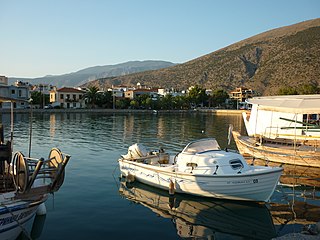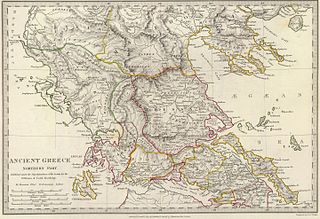Related Research Articles

Delphi, in legend previously called Pytho (Πυθώ), was an ancient sacred precinct and the seat of Pythia, the major oracle who was consulted about important decisions throughout the ancient classical world. The ancient Greeks considered the centre of the world to be in Delphi, marked by the stone monument known as the omphalos (navel).

The Pythian Games were one of the four Panhellenic Games of Ancient Greece. They were held in honour of Apollo at his sanctuary at Delphi every four years, two years after the Olympic Games, and between each Nemean and Isthmian Games. The Pythian Games were founded sometime in the 6th century BC. In legend they were started by Apollo after he killed Python and set up the oracle at Delphi. They continued until the 4th century AD.

The Castalian Spring, in the ravine between the Phaedriades at Delphi, is where all visitors to Delphi — the contestants in the Pythian Games, and especially pilgrims who came to consult the Delphic Oracle — stopped to wash themselves and quench their thirst; it is also here that the Pythia and the priests cleansed themselves before the oracle-giving process. Finally Roman poets regarded it as a source of poetic inspiration. According to some mythological versions it was here that Apollo killed the monster, Python, who was guarding the spring, and that is why it was considered to be sacred.

A sacrificial tripod, whose name comes from the Greek meaning "three-footed", is a three-legged piece of religious furniture used in offerings and other ritual procedures. This ritual role derives from its use as a simple support for a cooking vessel placed over a fire. As a seat or stand, the tripod is the most stable furniture construction for uneven ground, hence its use is universal and ancient.

Artemisia I of Caria was a queen of the ancient Greek city-state of Halicarnassus and of the nearby islands of Kos, Nisyros and Kalymnos, within the Achaemenid satrapy of Caria, in about 480 BC. She was of Carian-Greek ethnicity by her father Lygdamis I, and half-Cretan by her mother. She fought as an ally of Xerxes I, King of Persia against the independent Greek city states during the second Persian invasion of Greece. She personally commanded her contribution of five ships at the naval battle of Artemisium and in the naval Battle of Salamis in 480 BC. She is mostly known through the writings of Herodotus, himself a native of Halicarnassus, who praises her courage and the respect in which Xerxes held her.
In Archaic Greece, an amphictyony, or amphictyonic league, was an ancient religious association of tribes formed before the rise of the Greek poleis.

The so-called Battle of Crocus Field was a battle in the Third Sacred War, fought between the armies of Phocis, under Onomarchos, and the combined Thessalian and Macedonian army under Philip II of Macedon. In the bloodiest battle recorded in Ancient Greek history, the Phocians were decisively defeated by Philip's forces. Philip's victory secured his appointment as ruler of Thessaly, marking an important step in the rise of Macedon to political ascendancy in Ancient Greece. Opinion amongst historians is divided as to the year of the battle; some favour 353 BC, and others 352 BC.

Kirra is a village in Phocis, Central Greece. It is part of the municipal unit of Itea, to which it is adjacent. Kirra is the point where the Pleistos river meets the Gulf of Iteas, a bay of the Gulf of Corinth.

The Pleistos is a river in central Greece. It drains the Pleistos valley, named after it, a relatively recent rift valley north of the Gulf of Corinth, and parallel to it. They have the same geologic causes. Being situated in karst topography, much of the river runs or seeps through underground channels. The surface stream is intermittent. However, the limestone riverbed reflecting the light gives the appearance of a stream of water.
The Third Sacred War was fought between the forces of the Delphic Amphictyonic League, principally represented by Thebes, and latterly by Philip II of Macedon, and the Phocians. The war was caused by a large fine imposed in 357 BC on the Phocians by the Amphictyonic League, for the offense of cultivating sacred land; refusing to pay, the Phocians instead seized the Temple of Apollo in Delphi, and used the accumulated treasures to fund large mercenary armies. Thus, although the Phocians suffered several major defeats, they were able to continue the war for many years, until eventually all parties were nearing exhaustion. Philip II used the distraction of the other states to increase his power in northern Greece, in the process becoming ruler of Thessaly. In the end, Philip's growing power, and the exhaustion of the other states, allowed him to impose a peaceful settlement of the war, marking a major step in the rise of Macedon to pre-eminence in Ancient Greece.
Cirrha or Kirra was a town in ancient Phocis on the coast, which served as the harbour of Delphi. Pausanias erroneously supposes that Cirrha was a later name of the Homeric Crissa. They were two separate towns, with interlinked histories.

The Perrhaebi were an ancient Greek people who lived on the western slopes of Olympus, on the border between Thessaly and Macedonia. They took part in the Trojan War under Guneus and also fought in the Battle of Thermopylae.
In Ancient Greek Religion and mythology, Enodia is a distinctly Thessalian Ancient Greek goddess, identified in certain areas or by certain ancient writers with Artemis, Hecate or Persephone. She was paired with Zeus in cult and sometimes shared sanctuaries with him. Enodia was primarily worshipped in Ancient Thessaly and was well known in Hellenistic Macedonia.

International Delphic Council (IDC) is a not-for-profit, charitable, non-political, non-religious, non-sectarian & non-governmental organisation (NGO), headquartered in Berlin, Germany. It was formed as a League of 20 Nations in 1994 in Berlin to revive the Delphic Games of the Modern Era, although there is a separate organisation, International Delphic Committee, headquartered in Russia, created after Russia NDC split from the international Delphic Council in the year 2000 and works in the CIS region.

Phocis was an ancient region in the central part of Ancient Greece, which included Delphi. A modern administrative unit, also called Phocis, is named after the ancient region, although the modern region is substantially larger than the ancient one.

The Stadium of Delphi lies on the highest spot of the Archaeological Site of Delphi. It overlooks the sanctuary of Apollo and has a view to the Delphic landscape. It was built either within the second half of the 4th century B.C. or even after the Galatian attacks. Its measured 178 meters in length and knew several refurbishment phases. The Stadium of Delphi is the best preserved ancient stadium in Greece.

The Treasury of the Sicyonians is one of the buildings within the sanctuary of Apollo in Delphi. It has a long and complicated history. The treasury itself replaced two former buildings, namely the tholos and the monopteros, built by the same city at an earlier stage within the 6th century. The earlier buildings were related to the Orthagorids of Sicyon and particularly to the victories of the tyrant Cleisthenes of Sicyon in the course of the First Sacred War and their replacement probably marks the change in tide in Sicyonian politics.

Behind the column with the Dancers of Delphi was situated the Athenian Treasury, where was located the famous ex voto of Daochos, a long marble base where stood nine statues, eight of which represented members of Daochos' family and one a god, probably Apollo. Daochos II, son of Agias, a politician from Pharsalus and supporter of Macedonia, was a hieromnemon at the delphic sanctuary from 336 to 332 B.C. He dedicated the ex voto as a sign of honour to his prominent family.

The modern town of Delphi is situated immediately west of the archaeological site of the same name. The town was created as a home for the population of Castro, which was relocated to allow for the excavation of the site of ancient Delphi. The importance of the twin locations grew to the point where Delphi has also been made the name of the modern-day municipality, which includes the communities of the Plaistos valley system as far south as the Gulf of Corinth. The name Delphi came from the Oracle of Delphi, which was anciently accepted as a purveyor of truth revealed by the god Apollo.
References
- ↑ An Epitome of the Civil and Literary Chronology of Greece. By Henry Fynes Clinton. Pg 92
- ↑ Ep. 27.4 English translation in Pseudepigraphic Writings: Letters - Embassy - Speech from the Altar - Decree p. 115. Greek text and French translation in Hippocrate - Œuvres complètes, traduction Littré, 1839 volume 9 p. 412-413
- 1 2 3 Mayor, Andrienne. Greek fire, poison arrows, and scorpion bombs: Biological and chemical warfare in the ancient world. The Overlook Press, Peter Mayer Publishers, Inc., 2003. ISBN 1-58567-348-X. pages 100–101
- ↑ Frontinus, Stratagems 3.7.6
- ↑ Polyaenus, Stratagems 6.13